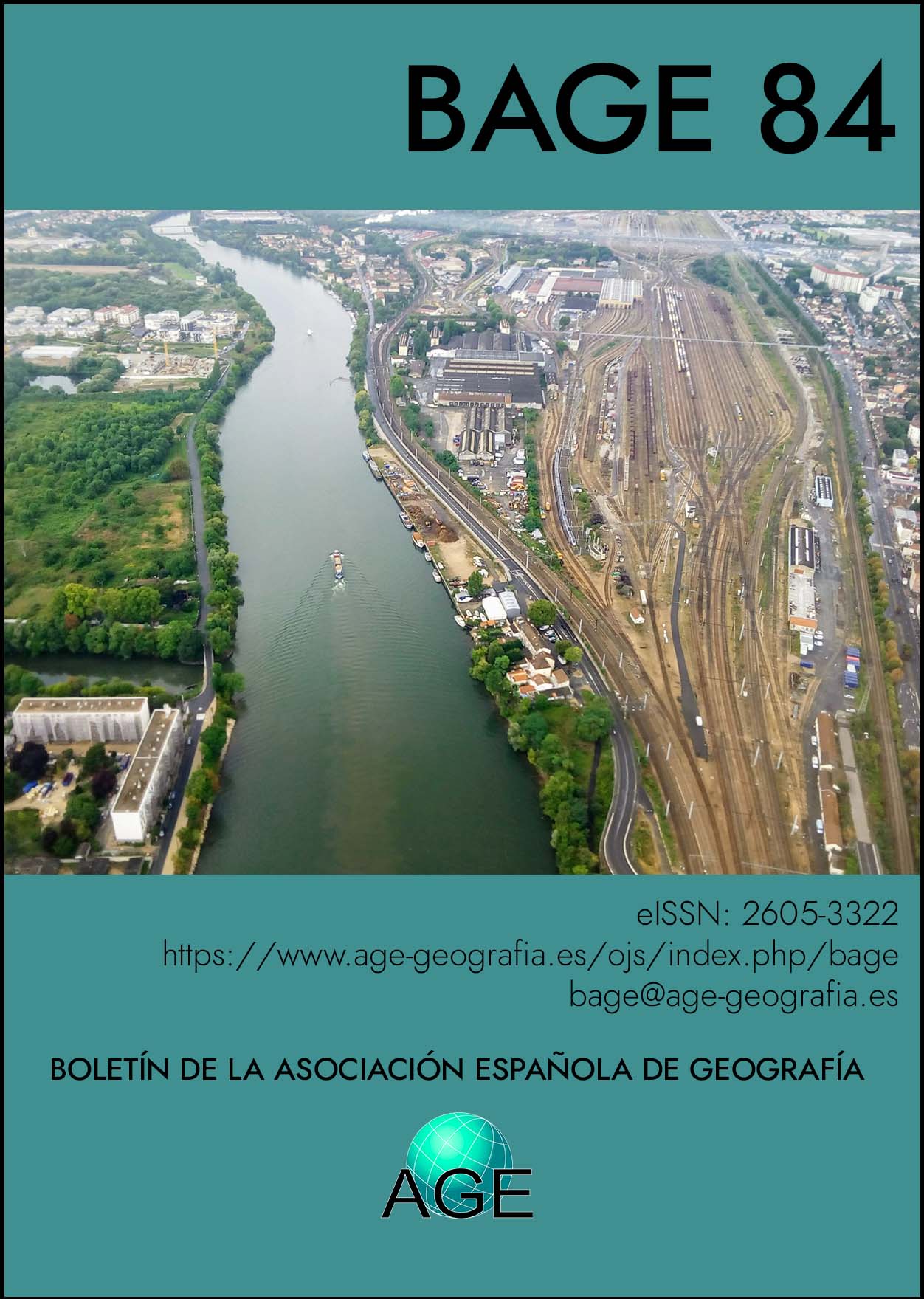The image of the city in automotive advertising
Main Article Content
Abstract
Urban mobility model based on the use of the private car has important environmental and spatial consequences in contemporary cities. Nonetheless, the automotive industry has attempted to refuse these negative impacts employing a rhetoric discourse following their self-interests. Advertising has become a valuable tool for that purpose: beyond its commercial function, it transfers to the consumer certain symbolic meanings that are juxtaposed on the car in so far as merchandise. Thus, through the advertising message, an intentional and biased image of urban landscapes and public spaces is constructed, playing an important role at the service of the car industry and the road traffic. This paper addresses these mechanisms of production and reproduction of a deliberate image through the Critical Discourse Analysis. For that purpose, a sample of 81 car adverts broadcasted in Spanish TV channels was examined. Using both representations of specific cities and other idealized models, it is concluded that car advertising projects a softened urban image, reducing the complexity of urban forms and functions to a mere scenery.
Downloads
Article Details
References
ANFAC (Asociación Española de Fabricantes de Automóviles y Camiones) (2018). Informe Anual, 2017. Retrieved from http://www.anfac.com/documents/tmp/MemoriaANFAC2017.pdf
Australian Bureau of Statistics (2017). Census of Population and Housing, 2016, Great Melbourne Census QuickStats. Retrieved from http://quickstats.censusdata.abs.gov.au/census_services/getproduct/census/2016/quickstat/2GMEL?opendocument
Bardin, L. (1996). El análisis de contenido (2nd ed.). Madrid: Akal.
Bargueno, M. A. (2016, April 13). ¿Quiénes conducen los coches de los anuncios? No son actores. El País Motor. Retrieved from https://motor.elpais.com/actualidad/nos-gustan-tanto-los-anuncios-coches/
Bates, J., & Leibling, D. (2012). Spaced Out. Perspectives on parking policy. London: RAC Foundation.
BMW Group España (2015). Comunicado de prensa, 21 de agosto de 2015. Retrieved from https://www.press.bmwgroup.com/spain/article/attachment/T0231022ES/324351
Borja, J., & Muxí, Z. (2003). El espacio público: ciudad y ciudadanía. Barcelona: Diputació de Barcelona.
Chester, M., Fraser, A., Matute, J., Flower, C., & Pendyala, R. (2015). Parking infrastructure: A constraint on or opportunity for urban redevelopment? A study of Los Angeles County parking supply and growth. Journal of the American Planning Association, 81(4), 268–286. https://doi.org/10.1080/01944363.2015.1092879
Delgado, M. (2007). Sociedades Movedizas. Barcelona: Anagrama.
Dennis, K., & Urry, J. (2011). Un mundo sin coches, Barcelona: Península.
Dowling, R., & Simpson, C. (2013). ‘Shift – the way you move’: reconstituting automobility. Continuum, 27(3), 421–433. https://doi.org/10.1080/10304312.2013.772111
Eurostat (2018). Housing statistics. Retrieved from https://ec.europa.eu/eurostat/statistics-explained/index.php/Housing_statistics
García Martín, M. (2018). ¿Te gusta conducir? Una mirada crítica desde la publicidad de coches y su retórica medioambiental. Didáctica de las Ciencias Experimentales y Sociales, 34, 91–104. https://doi.org/10.7203/dces.34.11008
Gil de Arriba, C. (2002). Ciudad e imagen. Un estudio geográfico sobre las representaciones sociales del espacio urbano de Santander. Santander: Universidad de Cantabria.
Hee, L., & Dunn, S. (2017). Urban Mobility: 10 Cities Leading the Way in Asia Pacific. Singapore: Centre for Liveable Cities & Urban Land Institute. Retrieved from https://www.clc.gov.sg/docs/default-source/books/carlite_urban_mobility_interactive-pdf.pdf?sfvrsn=babf0a39_0
Johnson, M. P. (2001). Environmental impacts of urban sprawl: a survey of the literature and proposed research agenda. Environment and Planning A, 33(4), 717–735.
Krippendorff, K. (1980). Content analysis: An introduction to its methodology. Newbury Park, London, New Delhi: Sage.
Litman, T. (2017). Evaluating Transportation Land Use Impacts. Considering the Impacts, Benefits and Costs of Different Land Use Development Patterns. Victoria (BC): Victoria Transport Policy Institute.
Mata Olmo, R., & Sanz Herráiz, C. (Dirs.) (2003): Atlas de los Paisajes de España. Madrid: Ministerio de Medio Ambiente.
Merriman, P. (2009). Automobility and the geographies of the car. Geography Compass, 3(2), 586–599.
Navarro Susaeta, P., & Díaz Martínez, C. (1994). Análisis de contenido. In J. M. Delgado & J. Gutiérrez Fernández (Coords.), Métodos y técnicas cualitativas de investigación en ciencias sociales (pp. 177–224). Madrid: Síntesis.
Ricart, N., & Remesar, A. (2013). Reflexiones sobre el espacio público. On the W@terfront, 25, 5–35.
Riesco Chueca, P., & López Suero, T. (2009). Automóvil, ciudad y diseño: un fermento estilístico en el paisaje urbano. In C. Tapia Martín & M. Varona Gandulfo (Eds. and Coords.), Actas de los seminarios de apoyo a la investigación Hibridación y Transculturalidad en los modos de habitación contemporánea. El territorio andaluz como matriz receptiva (pp. 137–146). Sevilla: Universidad de Sevilla.
Rode, P., Floater, G., Thomopoulos, N., Docherty, J., Schwinger, P., Mahendra, A., & Fang, W. (2017). Accessibility in cities: transport and urban form. In G. Meyer & S. Shaheen, Disrupting mobility (pp. 239–273). Cham: Springer. https://doi.org/10.1007/978-3-319-51602-8_15
Rodrigue, J. P. (2017). The Geography of Transport Systems (4th ed.). New York: Routledge.
Rodríguez Borges, R. F. (2011). Esfera pública y medios de comunicación. La contribución de los media a la construcción de la ciudadanía democrática. Daimon Revista Internacional de Filosofia, sup. 4, 79–93.
Salter, R., Dhar, S., & Newman, P. (2011). Technologies for Climate Change Mitigation - Transport Sector. Roskilde: Riso Centre for Energy, Climate and Sustainable Development, United Nations Environment Program.
Sánchez Revilla, M. A. (2019). Estudio InfoAdex de la Inversión Publicitaria en España 2019. Retrieved from https://www.infoadex.es/home/estudio-infoadex-de-la-inversion-publicitaria-en-espana-2019/
Segovia Martín, R. (2007). Los discursos publicitarios en la imagen social del transporte: lo privado vs lo público. Cuadernos de Geografía de la Universitat de València, 81–82, 119–132.
Sheller, M., & Urry, J. (2000). The city and the car. International journal of urban and regional research, 24(4), 737–757.
Shoup, D. C. (2005). The high cost of free parking. Chicago: Planners Press, American Planning Association.
Swanwick, C., & Land Use Consultants (2002): Landscape Character Assessment: Guidance for England and Scotland. Cheltenham: The Countryside Agency; Edinburgh: Scottish Natural Heritage.
United Nations Human Settlements Programme (2013). Planning and design for sustainable urban mobility. Global report on human settlements 2013. Abingdon; New Yok: Routledge.
Urry, J. (2011). Climate Change & Society. Cambridge; Malden (MA): Polity Press.
Van Dijk, T. A. (2009). Discurso y poder. Barcelona: Gedisa.
Wodak R., & Meyer, M. (2003). Métodos de análisis crítico del discurso. Barcelona: Gedisa.
Zárate Martín, M. A., & Rubio Benito, M. T. (2005). Geografía Humana. Sociedad, Economía y Territorio. Madrid: Ramón Areces.

